
A Scientific Guide to Posting Tweets, Facebook Posts, Emails, and Blog Posts at the Best Time
Update: We looked at 4.8 million tweets sent through Buffer to find the best time to tweet for clicks, retweets, favorites, and more. See the results for your specific time zone!
This post was originally published in August 2013. We’ve updated it here with new research and visuals.
We’re pretty keen on optimal timing for social media here at Buffer, and I figured it was high time I collected all the information we have about online communication into one place. I’ve collected research and stats on Twitter, Facebook, email and blogging to help you find the best time to communicate with others in each format.
The tricky thing I’ve come across is that since the web is still so new, a lot of the research available to us is conflicting. We really need more time and more studies to get definitive answers about what works best, and the fact that our audience members are constantly changing their own activity patterns makes it even harder to work out for sure. Looking at the latest social media stats seems to only confirm that.
So my suggestion would be to use this guide as just that—a guide to help you work out what to test for your own audience, so that you can see what actually works best in your specific case.
Let’s get into the stats then!
Update: Social media scheduling is something Kevan Lee teaches in our social media strategies email course—you can join the course for free here!


Facebook – find the best time to post your updates
In our research into Facebook’s News Feed algorithm, we found that one of the key considerations to the visibility of a post is engagement—clicks, comments, reshares, etc. Therefore, finding an ideal time for engagement could be a boon to getting your Facebook post more reach.
In terms of specific days and times to post on Facebook, here are some of the stats I found:
Engagement rates are 18% higher on Thursdays and Fridays.
I love the way this was explained in Buddy Media’s study: as they put it, “the less people want to be at work, the more they are on Facebook!”
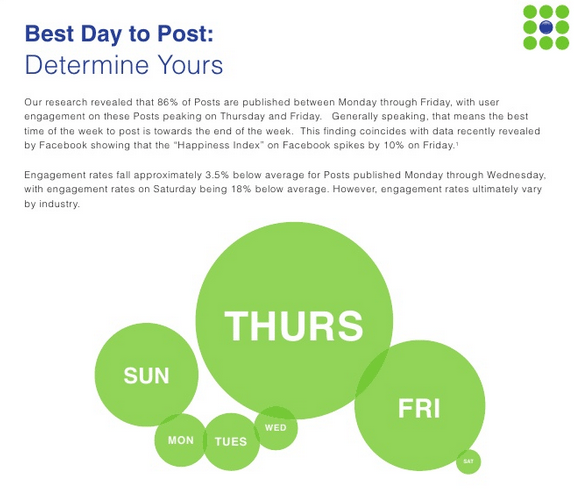
Specific industries varied slightly in which days of the week garnered the most engagement, but most of them sit around the end of the week, from Wednesday to Friday.
Another study found that engagement was 32% higher on weekends, so the end of the week is definitely a good, rough guide to start experimenting with. The following infographic from KISSmetrics and Dan Zarrella describes it well:
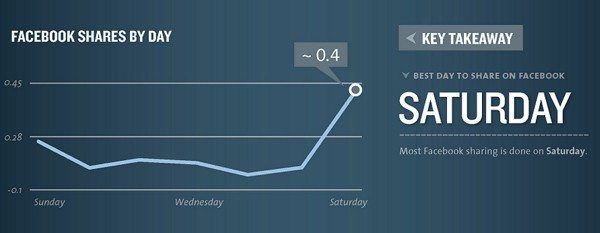
The best time of day to post on Facebook is debatable, with stats ranging from 1:00 p.m. to get the most shares, to 3:00 p.m. to get more clicks, to the broader suggestion of any time between 9:00 a.m. and 7:00 p.m. It seems that this generally points to early afternoon being a solid time to post, and anytime after dinner and before work being a long shot.
For more Facebook stats, we’ve written a complete Facebook guide for you to check out.
Twitter – when is the best time to tweet for engagement vs. clicks
Twitter is such a popular network for mobile users that it can be a bit tricky to lock down exactly when the best time to post is. Here are some suggestions from the research I’ve found:
Twitter engagement for brands is 17% higher on weekends according to Dan Zarrella’s research.
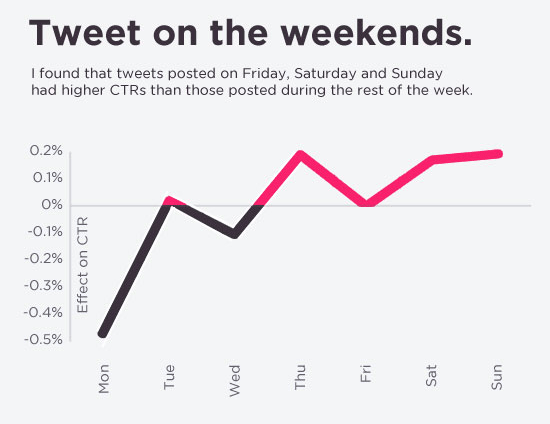
If you’re tweeting from your company account, you might want to keep this in mind, especially if engagement is what you’re looking for. Buffer can help you spread out your tweets to post at the optimal times, so you don’t even have to work weekends to take advantage of this! Click-through rates are generally highest on weekends, as well as mid-week, on Wednesdays.
On the other hand, an Argyle Social study showed that weekdays provide 14% more engagement than weekends, so this is definitely one you’ll want to test on your audience.
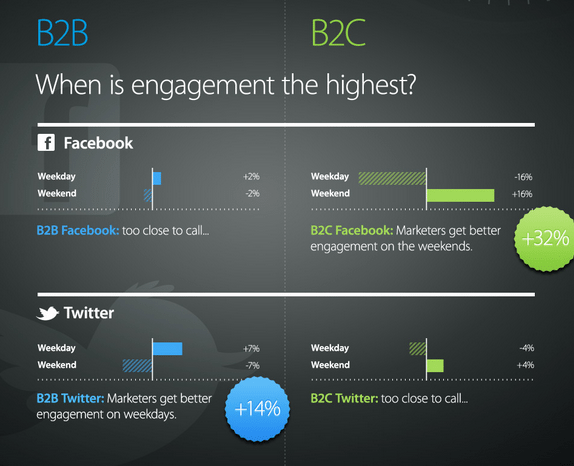
When we look at the time of day, retweets have been shown to be highest around 5pm.
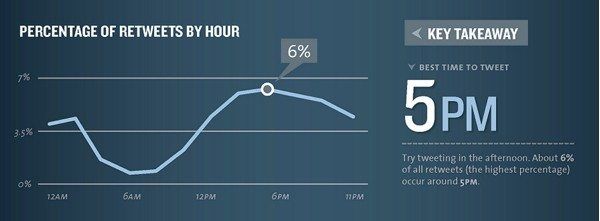
For click-throughs, the best times seem to be around noon and 6pm.
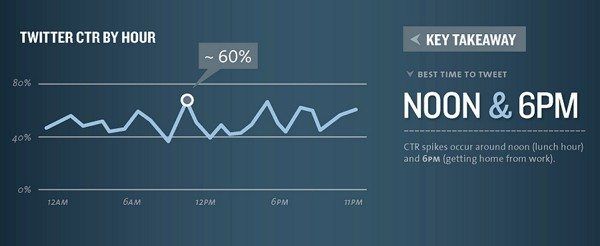
This could be due to lunch breaks and people looking for something to keep them occupied on the commute home after work.
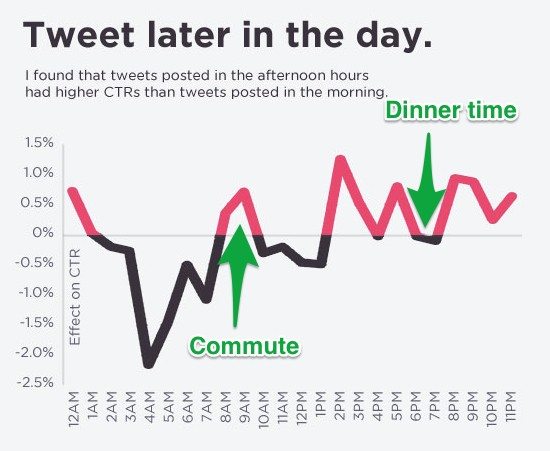
There are lots of Twitter users who primarily use a mobile device—rarely loading up Twitter on their desktops. Twitter did an interesting study of these users and found that they are 181% more likely to be on Twitter during their commute.
They’re also 119% more likely to use Twitter during school or work hours.
For more details on the latest Twitter stats and Twitter statistics, check out this Twitter guide.
Email – find the best time to send for the right content
There’s been lots of research done on the best time to send emails, particularly in the case of email marketing. Some research done by Dan Zarrella from Hubspot broke down each time of day and worked out which type of emails work best for that period. Here’s what he found:
- 10pm–6am: This is the dead zone, when hardly any emails get opened.
- 6am–10am: Consumer-based marketing emails are best sent early in the morning.
- 10am-noon: Most people are working, and probably won’t open your email.
- Noon–2pm: News and magazine updates are popular during lunch breaks.
- 2–3pm: After lunch lots of people buckle down and ignore their inbox.
- 3–5pm: Property and financial-related offers are best sent in the early afternoon.
- 5–7pm: Holiday promotions & B2B promotions get opened mostly in the early evening.
- 7–10pm: Consumer promotions are popular again after dinner.
What I thought was really interesting about this breakdown is why each type of email is more popular at certain times. From 3–5pm, for instance, the reason people open financial and property-related emails is that they’re more likely to be thinking about their life situation and how to improve it. Understanding how these time blocks work can be a good start to sending your emails at just the right time.
And since 23.63% of emails are opened within an hour of being received, this is something we definitely want to get right.
For more general emails, open rates, click-through rates and abuse reports were all found to be highest during early mornings and on weekends.
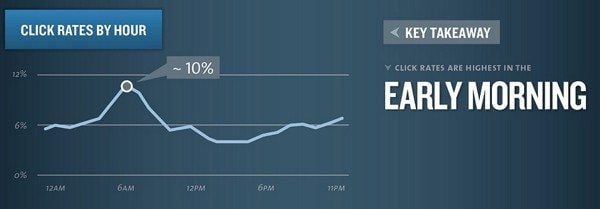
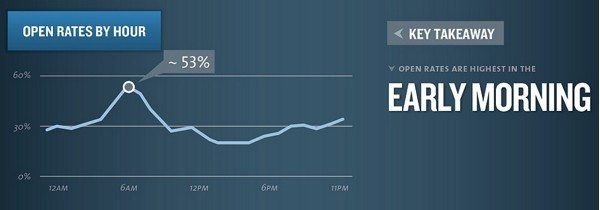
This probably means that most of us have more time to dedicate to our inbox during these periods, rather than during the day when we’re trying to get work done.


In a different study by MailChimp open rates were shown to be noticeably lower on weekends.

They also found that open rates increased after 12pm, and were highest between 2pm and 5pm.

A GetResponse study backed this up by showing that open rates drop off slightly, and click-through rates drop significantly on weekends.
GetResponse found that Thursday is the best day for both open rates and click-throughs.
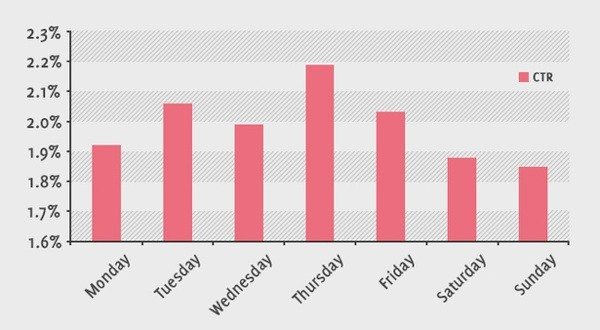
Mark Suster offers some great advice when it comes to sending emails:
Often I’ll write emails on the weekend and then send first thing Monday morning. I want to be on top of the stack, not at the bottom of the pile. Most people process email first thing in the morning (although productivity experts say not to!).
BTW, when I wrote blog posts on Sundays I always tweet again Monday morning for exactly this reason.
Blog posts – what time should you hit publish on your posts?
So let’s take a look at when to publish blog posts.
Dan Zarrella has some more great stats on this topic, but he makes a good point about the pros and cons of the timing you choose. One thing Dan suggests we consider is that if we post during time of higher traffic, we’re more likely to have higher bounce rates and get lost amongst the noise of other content being published.
On the other hand, posting at times when fewer people are online will garner less traffic and engagement, but give our posts more prominence and less competition against other content.
Here are some useful stats from Dan’s research into blog timing:
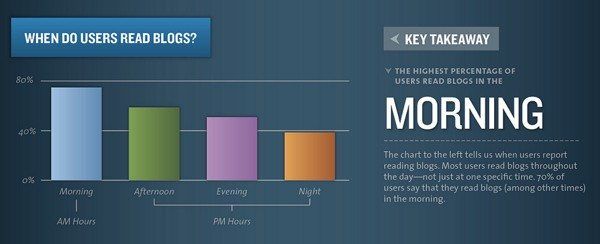
- 70% of users say they read blogs in the morning
- More men read blogs at night than women
- Mondays are the highest traffic days for an average blog
- 11am is usually the highest traffic hour for an average blog
- Comments are usually highest on Saturdays and around 9am on most days
- Blogs that post more than once per day have a higher chance of inbound links and more unique views
Knowing your audience is obviously important for working out the best time to publish on your blog. If your audience is women, for instance, mornings are probably a better bet than nights.
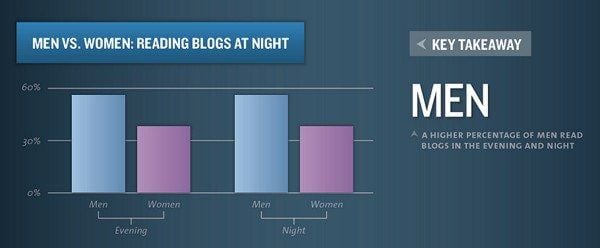
While Mondays are the best days to publish for traffic, Social Fresh suggests posting on a Thursday for more social shares across the web. Here are also more ideas to find the best time to publish blogposts.
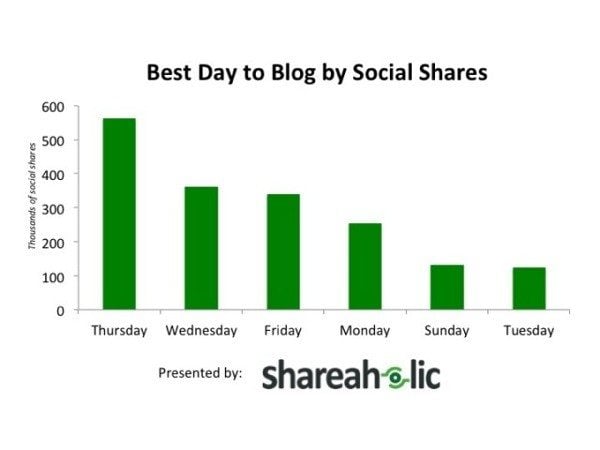
This study also found that most content sharing happens in the morning, which backs up Dan’s stats that mornings are the most popular time to read blogs.
With Buffer’s new custom scheduling feature, you can now publish your post whenever suits you and schedule it to be promoted on social networks at a more optimal time. Plus, you can now send and schedule posts to Google+ from Buffer!
Timing depends on the individual
Timing is difficult to get exactly right, and a big part of this is because we all have different schedules and routines for checking email or using social media. An experiment by online retailer eBags showed this point perfectly. Looking at the latest social media statistics the range of different schedules seems to only increase too.
The company thought that when users were signing up to an email list, that was probably a good time of day for them to be online, so sending emails to them at that same time of day would work best. By analyzing the behavior of each individual user, eBags sent out emails to users at the same time of day they had signed up for the email list.
This actually worked incredibly well: click-through rates rose by 20% and conversion rates rose by 65%.
Unfortunately, this is such a complicated and time-consuming process that it wasn’t sustainable. Hopefully these kind of features can be built into social media and email management tools in the future so we can all take advantage of these insights!
Over to you
Since it’s still so difficult to find the optimal time for each type of online communication that will work for everyone, I’d love to hear about your personal experiences. What works best for you? You can comment below, send me an email or catch me on Twitter at @bellebethcooper.
Get more social media strategies by email
Optimizing your schedule is one of the strategies Kevan Lee covers in the free Actionable Social Media Strategies email course. We’d love to share some practical methods on timing your tweets with you there. (We’ll also keep you in the loop with more social media tips!)
Image sources: Social timing infographics from Dan Zarrella, KISSmetrics, Bit.ly and Argyle Social.
Try Buffer for free
140,000+ small businesses like yours use Buffer to build their brand on social media every month
Get started nowRelated Articles

In this article, Nupur Mittal shares insights into four research methods that help her find content ideas and identify unique takeaways.
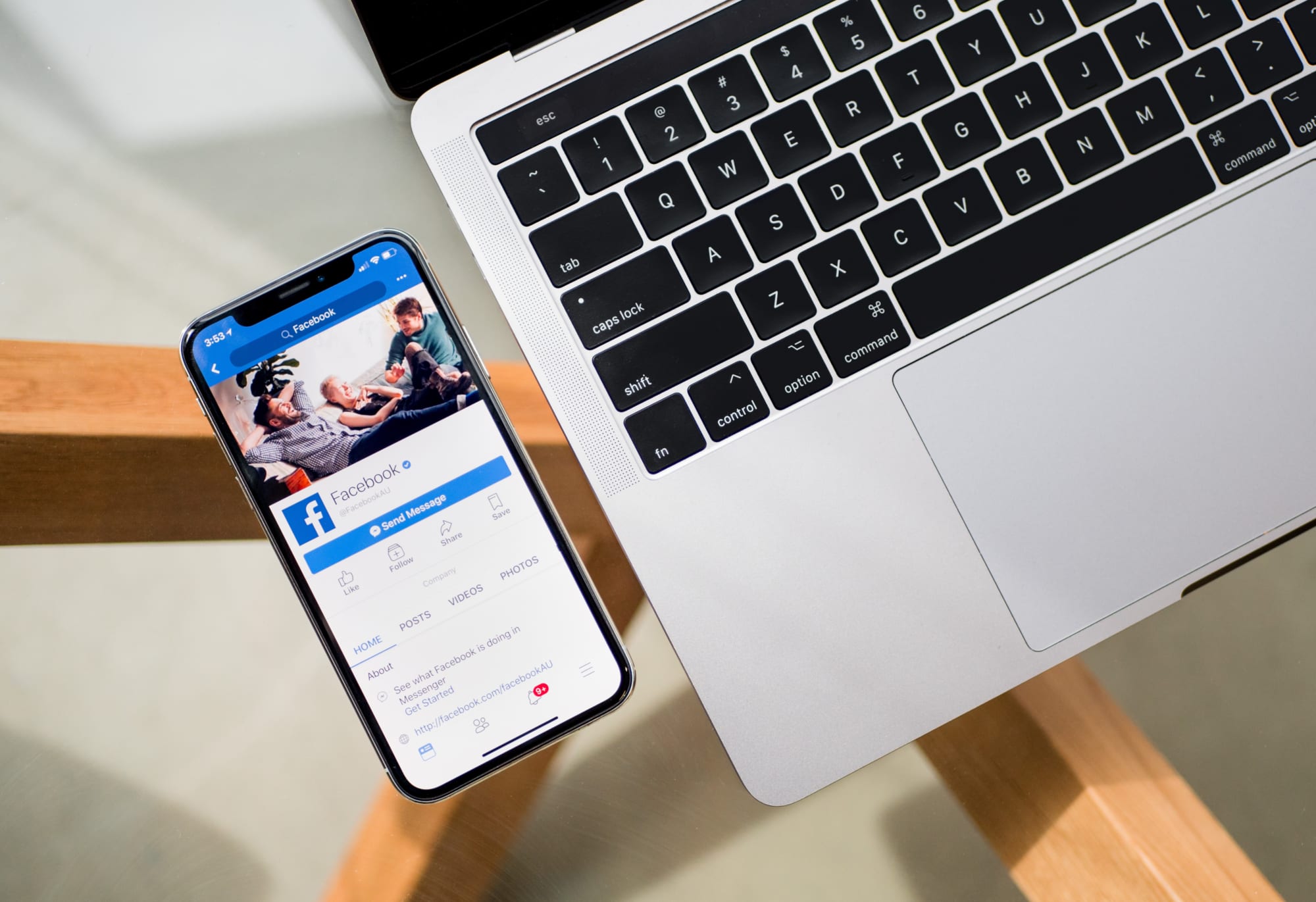
Facebook marketing in 2019 isn’t dead. On the contrary, it’s far from it. Now removed from the dim outlook that businesses faced at the beginning of 2018, Facebook has and will remain an essential tool for brands’ marketing strategies moving forward. In our big State of Social Media 2019 Report, we found that 93.7 percent of businesses use and are currently active on Facebook — the most among any other social media network. And although we continue to see a dramatic rise in the usage
